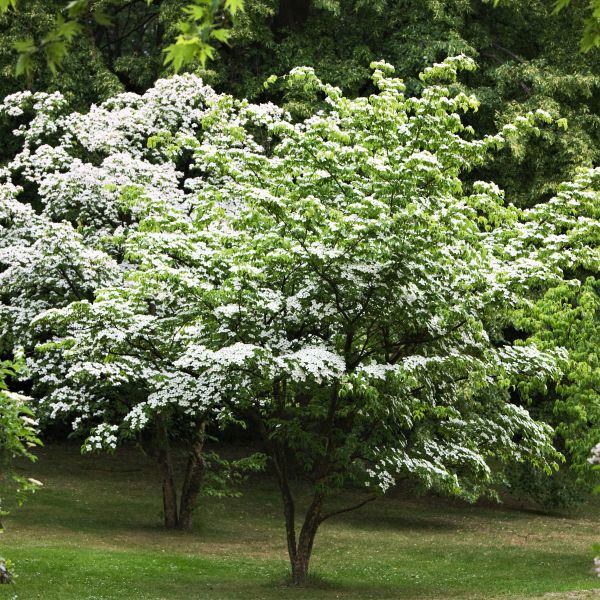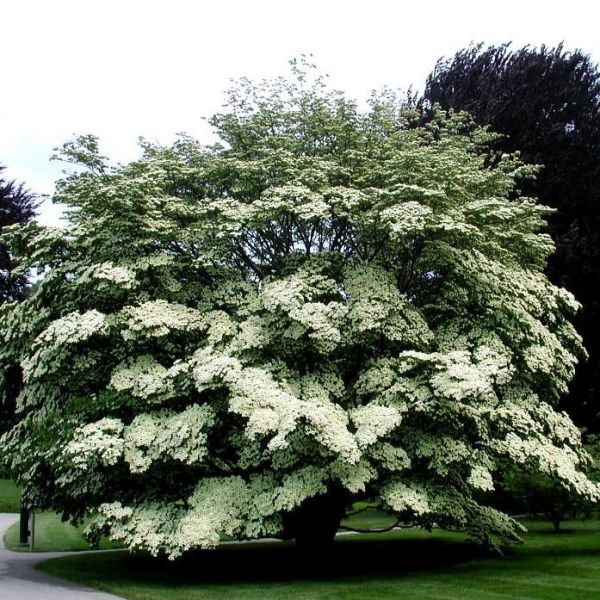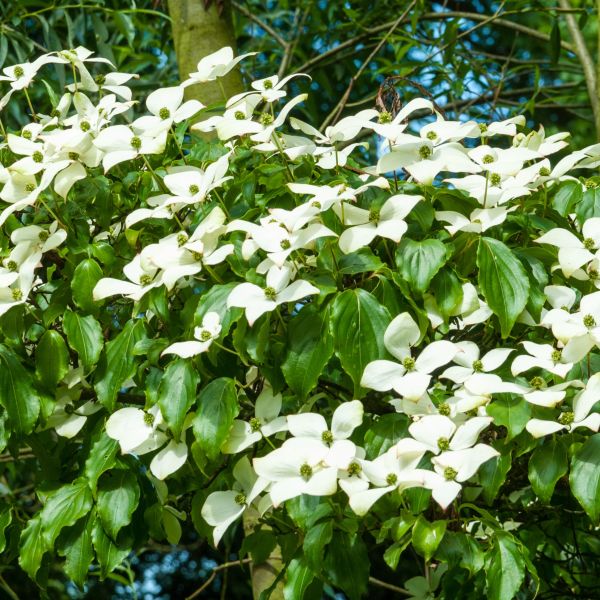


Kousa Dogwood
Cornus kousa
92 reviews
Kousa Dogwood
Cornus kousa
92 reviews
- 3.5 Gallon 4-5 Feet
- Container 4-5 Feet
We are sorry, product is currently out of stock due to seasonal availability. Please check the "Related plants available in your area" section below
Not just beautiful - intentionally selected by ShrubHub's 3D landscape design team to fit real-world spaces and maximize yard potential.
Why Kousa Dogwood?
Kousa dogwood is a small, ornamental tree that produces showy, white or pink flowers in late spring to early summer. It is highly valued for its attractive bark, resistance to pests and disease, and its ability to thrive in a variety of soil types and climates. Its fruit is edible and resembles a raspberry in appearance. Kousa dogwood is also a great tree for attracting birds and other wildlife to your garden.
Sunlight
Kousa Dogwood requires full to partial sunlight, ideally about 4 to 6 hours of direct sunlight per day.
Watering
Kousa Dogwood trees require regular watering, especially during dry periods, to maintain healthy growth. They prefer moist, well-draining soil and benefit from deep watering rather than frequent shallow watering.
Fertilizing
Kousa Dogwood generally requires a balanced fertilizer with a ratio of 10-10-10 or similar. It is important to follow the recommended dosage and application instructions on the fertilizer packaging to avoid over-fertilizing and causing harm to the plant.
Nothing says soothing, alluring, and delightful quite like kousa dogwoods.
With their year-round glamor and seasonal bursts of colors, these flowering dogwoods effortlessly take center stage in your outdoor space. Just like a great masterpiece on display, the Chinese dogwood (Cornus kousa) shows off a distinctive type of beauty for each season.
In spring, adorned with four petal-like, star-shaped creamy white bracts, the flowering dogwood fashions an eclectic outdoor space by blanketing your garden with a most dreamy, angelic glow. The beauty of these dogwood trees lingers come summer. The dark green leaves not only create a full-of-life summer garden but also provide homeowners with a shady getaway where they reconnect with nature and let go of their worries.
From the vibrancy and joy of the summer to the elegance of the fall foliage, the plant shares an interesting experience with every homeowner. Once fall is around the corner, it throws a spectacular show, displaying a wide array of shades, from purple and scarlet to fiery red and deep pink.
In addition to this exceptional beauty, kousa dogwood produces olive-shaped, pinkish-red fruits. Further beautifying the tree, these berries grow like drops of romantic charm, attracting birds and squirrels.
Winter is no different from any of these seasons. Even though the leaves drop like any other tree, the delicate beauty of the kousa dogwood remains, portrayed in its scaly bark.
Native to China, Japan, and Korea, this flowering dogwood ornamental tree grows up to 15 to 30 feet tall and wide, thrives best in full sun to partial shade, prefers loamy, moist, and well-drained soil, and nearly fits into any spot due to its shallow root system.
Give your yard a four-season visual appeal with the kousa dogwood. Order yours now!
Plant Information:
| Botanical Name: | Cornus kousa |
| USDA Zones: | 5 - 8 |
| Water: | Moderate |
| Exposure: | Full Sun |
| Soil Needs: | Widely Adaptable |
| Mature Height: | 20 - 30 feet |
| Mature Spread: | 20 - 30 feet |





Pollination Info
Pollination Information for Kousa Dogwood (Cornus kousa)
Kousa dogwood (Cornus kousa) is a small, deciduous tree native to Asia. It is known for its beautiful, showy flowers that bloom in late spring to early summer. The flowers are surrounded by four large, creamy white bracts that give the appearance of a single, large flower.
Pollination Process
The pollination process of Kousa dogwood involves both wind and insects. The tree has both male and female flowers on the same plant, but they are not self-fertile. In order to produce fruit, the pollen must be transferred from the male flowers to the female flowers.
Insect Pollinators
The main insect pollinators of Kousa dogwood are bees and flies. They are attracted to the flowers by their nectar and pollen. As they move from one flower to another, they transfer pollen from the male flowers to the female flowers, fertilizing them and allowing them to develop into fruit.
Wind Pollination
Although insect pollination is more common, Kousa dogwood can also be wind-pollinated. The male flowers produce abundant pollen that is carried by the wind to the female flowers. However, wind pollination is not as reliable as insect pollination and may result in lower fruit production.
Fruit Production
After successful pollination, Kousa dogwood produces red or pink, fleshy fruit that is edible, but not particularly tasty. The fruit is often used for making jams and jellies, or left on the tree for birds to eat.
Pollination Importance
Overall, pollination is crucial for the health and survival of Kousa dogwood trees. Without proper pollination, they will not produce fruit, which can impact their ability to reproduce and provide food for wildlife.
FAQ
Kousa Dogwood (Cornus kousa) FAQs
1. What is Kousa Dogwood?
Kousa Dogwood is a small to medium-sized deciduous tree native to Eastern Asia, including Japan, Korea, and China. It is primarily grown for its attractive and showy flowers and fruits, which resemble strawberries.
2. What are the characteristics of Kousa Dogwood?
Kousa Dogwood grows up to 25 feet in height with a spread of up to 30 feet. It produces large, showy, white or pink flowers in late spring to early summer, followed by bright red, edible fruits that ripen in fall. The leaves are medium green in color, turning to reddish purple in fall.
3. Where can I plant Kousa Dogwood?
Kousa Dogwood can be planted in moist, well-drained soil in full sun to partial shade. It can adapt to various soil types, but prefers moist, slightly acidic soil. It is tolerant to drought and heat.
4. What are the benefits of planting Kousa Dogwood?
Kousa Dogwood is an excellent landscape tree that provides year-round interest. Its beautiful flowers and fruits attract birds and butterflies. It is also resistant to many common diseases and pests that affect other dogwood species.
5. How do I care for Kousa Dogwood?
Kousa Dogwood requires regular watering during the first few years of planting to ensure proper growth and establishment. Fertilize with a slow-release fertilizer in early spring. Prune in late winter or early spring to remove any dead, damaged, or diseased branches.
6. Is Kousa Dogwood susceptible to any diseases or pests?
Kousa Dogwood is generally resistant to most common dogwood diseases, such as powdery mildew, anthracnose, and canker. However, it can be susceptible to leaf spot diseases and insect pests, such as scale and borers. Proper care, including regular watering and pruning, can help prevent these issues.
7. When is the best time to plant Kousa Dogwood?
The best time to plant Kousa Dogwood is in the fall or early spring, when the soil is moist and cool. Avoid planting during extreme temperatures or drought periods.
8. Can I eat the fruits of Kousa Dogwood?
Yes, the bright red fruits of Kousa Dogwood are edible and can be used to make jams, jellies, and other treats. They are similar in taste and texture to strawberries.
9. How do I propagate Kousa Dogwood?
Kousa Dogwood can be propagated by seeds or cuttings. Seeds should be stratified in moist sand for 3 to 4 months before planting in the spring. Cuttings should be taken in late summer or early fall and rooted under mist and heat.
10. How long does Kousa Dogwood live?
Kousa Dogwood can live up to 80 years or more with proper care and maintenance.
Planting & Care
Planting & Care for Kousa Dogwood (Cornus kousa)
Planting
- Choose a location with well-draining soil and partial shade to full sun exposure.
- Dig a hole that is twice as wide and as deep as the root ball.
- Loosen the soil at the bottom of the hole and add some organic matter, like compost, to promote healthy root growth.
- Place the root ball in the hole and backfill with soil, ensuring that the top of the root ball is level with the surrounding soil.
- Water the plant thoroughly and apply mulch around the base, but not touching the trunk, to conserve moisture and suppress weeds.
- Water regularly, especially during hot, dry weather.
Care
- Prune in late winter to early spring to remove any dead or diseased wood and to shape the plant as desired.
- Fertilize in spring with a balanced, slow-release fertilizer.
- Water regularly, especially during hot, dry weather.
- Monitor for pests and diseases, like dogwood anthracnose and borers, and treat promptly if detected.
Tips
- Kousa dogwoods can be grown as a single specimen or in a group to create a stunning display.
- Consider planting near a patio or deck to enjoy the beautiful flowers and fall foliage.
- Avoid planting near roadsides or areas with heavy salt exposure, as kousa dogwood is sensitive to salt spray.
Check Out These Verified Customer Reviews:
Customer Reviews
4.7 out of 5 based on 92 reviews
Thank you! Your review has been submitted.
Absolutely beautiful tree! The blossoms are stunning and it arrived in perfect condition.
Fast shipping and the plant was well protected in the packaging. Very happy with my order.
Beautiful tree, vibrant colors.
Item has been added to your cart.


